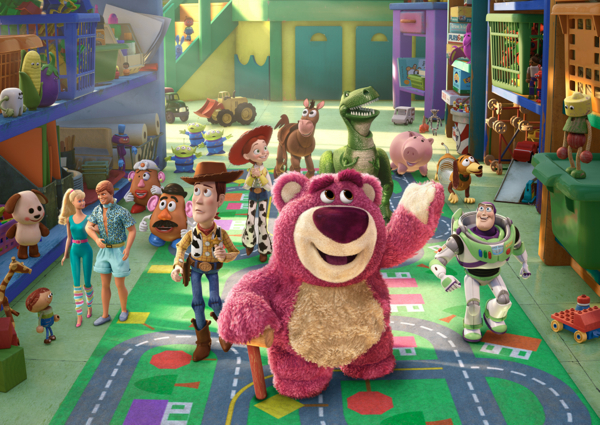Movie review by Greg Carlson
A deeply satisfying if imperfect conclusion (at least for now) to Pixar’s flagship franchise, “Toy Story 3” stands to make a fortune at the box office and win plenty of new converts to the beloved series. Boasting all the hallmarks of the company’s revered capacity for dazzling technical invention and nuts-and-bolts storytelling, “Toy Story 3” deftly balances the familiar and the novel, culminating in a tour de force display of emotions that range from sorrow to joy. Like its predecessors, “Toy Story 3” touches on the heartache that comes with the very essence of life’s transitory stages, and shares a profound understanding of what it means to love and be loved.
Following the terrific animated short “Day & Night,” “Toy Story 3” begins with an eye-popping runaway train fantasy that reestablishes cherished cowpoke Woody’s loyalty, pluck, and courage. Turns out Woody will need every ounce of those traits, as longtime owner Andy packs for college and intends to banish most of his old playthings to the attic. A misunderstanding brings what is left of the group – Bo Peep, Wheezy, Etch and others have been written out – to Sunnyside Daycare, a seemingly blissful promised land where toys won’t ever have to worry about their owners growing up. Woody, of course, insists that the friends must return home, whether Andy still wants them or not.
Like virtually any sequel, “Toy Story 3” introduces new characters, and one in particular is a humdinger. Ned Beatty’s Lotso, a plush, strawberry-scented bear with a mint julep drawl, rules Sunnyside with an air of privileged courtliness and capacity for mendaciousness that echoes Tennessee Williams’ Big Daddy Pollitt. Lotso, whose origin story is shared in flashback, runs Sunnyside like a penal colony, and the combination of his Old South manners and the forced chain-gang servitude of Andy’s toys allows for a diabolical parallel to antebellum history.
“Toy Story 3” is not without flaws. Cowgirl Jessie’s slightly diminished importance might remind some that the second film in the series is still the richest and most heartfelt. The Ken/Barbie subplot, with its crude waffling on Ken’s closeted sexuality, shifts too much attention away from the core gang, especially when the movie grinds to a halt for a superfluous montage set to Chic’s “Le Freak.” The mighty Buzz Lightyear, whose “Spanish mode” transforms the astronaut into a Latin lover, lacks some of his previous authority. Kyle Buchanan has already pointed out that the mechanics of the plot eerily resemble “A.I. Artificial Intelligence,” a parallel that should fuel a handful of film studies conference papers.
Of course, the tale of the “Toy Story” movies belongs first and last to Woody, and by the time the final scenes unfold, adult viewers, especially those with grown children, will be wiping away tears. The magnificence of the series rests largely with its refusal to ignore darkness and pain, and large themes, especially our fear of rejection and abandonment, guide the subtext of the trilogy toward surprisingly existential considerations – made all the more extraordinary by appearing in the seemingly disposable visages of the wood, plastic, and cloth toys that have come to mean so much to us.
